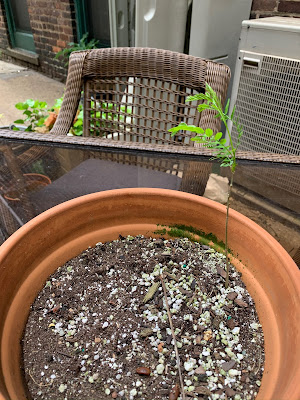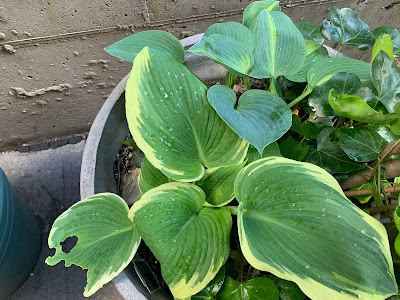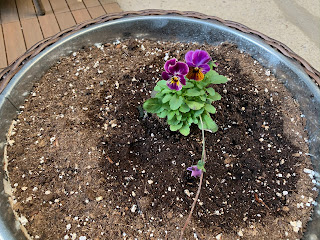Here's Pot 19. The tallest plant is a Price William Serviceberry, a tree that would blossom and produce berries if it had enough sunlight, which it doesn't. I've had it since 2016. Below it, the Key West Hosta, and behind that, the Marmalade Lime heuchera and the Creeping Jenny. All are thriving - though later in the season, the Serviceberry will develop some weird spots on its leaves. I've never been able to figure out why.
Pot 14B is next. Yes, I know it's out of order - I moved it last year, and I don't feel like renumbering it. This is the Empress Wu hosta. Empress Wu grows to be a very large hosta, so I may need a new pot sooner or later.
Pot 20 is the dwarf Alberta Spruce, which I bought from Whole Foods in early 2018. It will always be a tiny tree, but it's doing very nicely.
Pot 20A contains a new plant, the Beaujolais Heuchera.
Then we have Pot 14A, which is also out of numerical order. In this pot are two Astilbes, which I bought bare-root from Breck's this year. They are already beginning to bloom and are clearly going to be somewhere in the red family. Also in the pot, though you can't see it amidst all the Astilbe foliage, is a small Italian Maple tree that came as a stowaway with a hosta I bought in 2018. It's right in the center of this photo and easy to miss.
The next pot is unnumbered. It's the companion to the pot I showed you last week with the pansy in it, the pot that I wouldn't have bought if I'd known it's not insulated for winter. So I plunked an annual from the Greenmarket in this one too - a little yellow snapdragon.
Then there's Pot 21, which is Exhibit A in the "My Garden Wants to Be an Oak Forest" story. One Cathedral Windows hosta (purchased in 2018) is surrounded by three baby oak trees (self-planted, 2019).
Pot 22: one nearly-dead Christmas Fern, one new bare-root hosta from Breck's, and one self-seeded oak tree, whose leaves are very yellow for some reason.
Pot 23: an absurd amount of ivy, the Redstone Falls heucherella, and - somewhere in all that ivy - another baby oak tree.
Pot 24 is a windowbox with three hostas: Restless Sea, Electrocution, and Pilgrim. All are doing well..
And last but not least, Pot 26 contains the Eye Spy heucherella, from 2019, and the Marmalade Lime heuchera from 2018. Eye Spy is really thriving, and already blooming.
And there you are.

















































